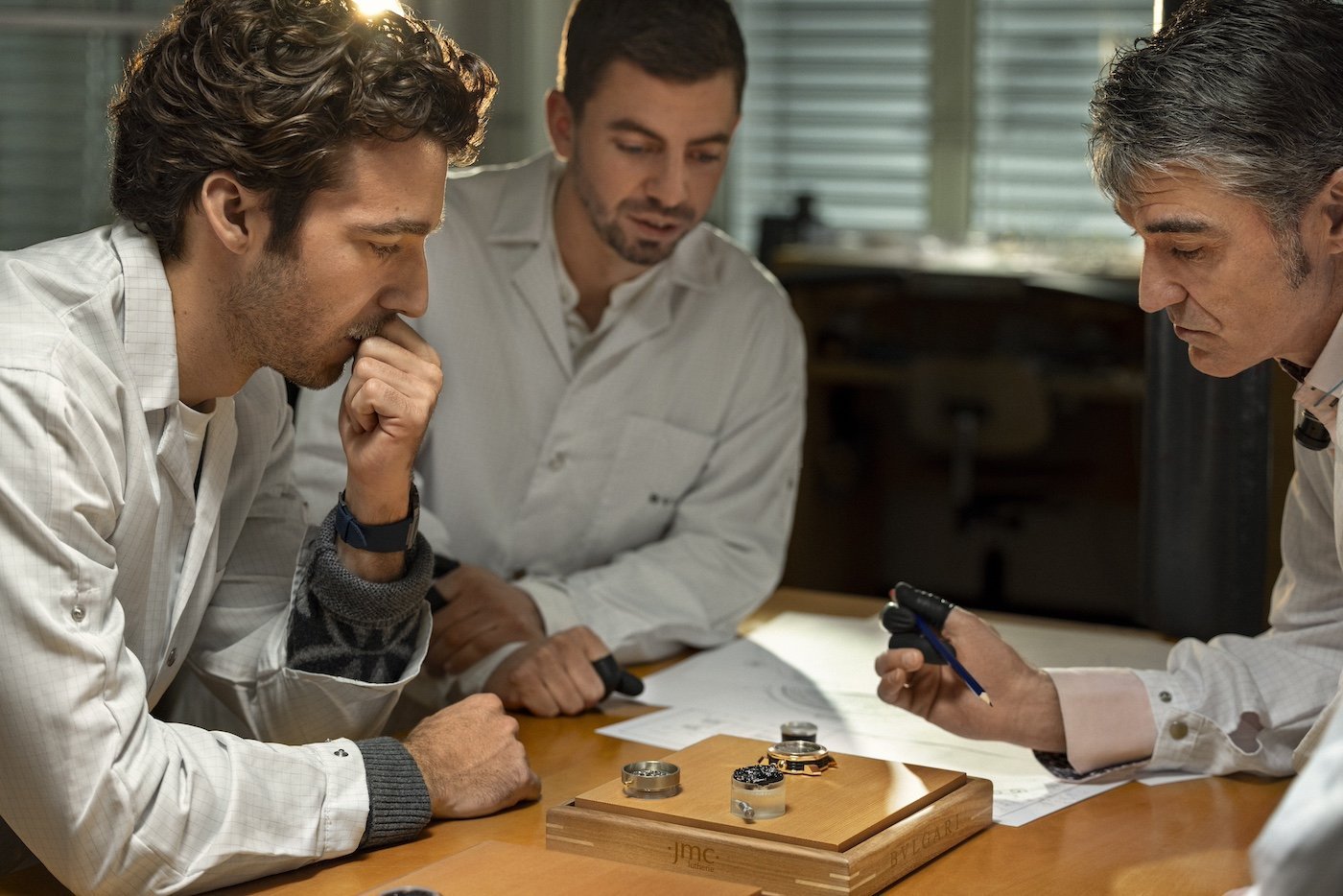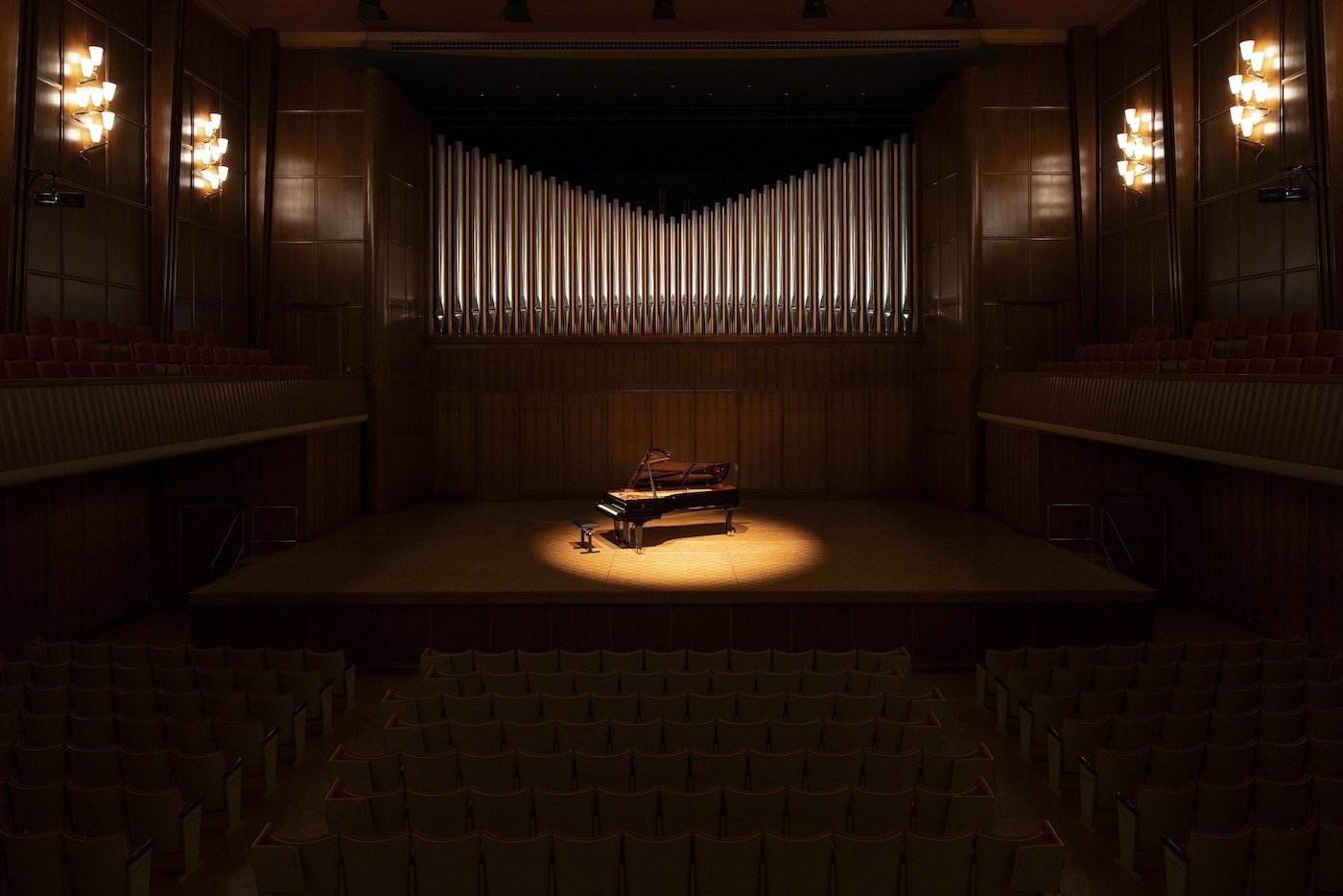vlgari CEO Jean-Christophe Babin sported a unique timepiece at the latest Geneva Watch Days: the Octo Roma Carillon Tourbillon. It is not the first time the Roman house has created a chiming watch, but this one, which strikes the hours, the quarters on three notes thanks to the new BVL428 carillon movement, and the minutes, is particularly special.
Instead of using the Westminster Carillon melody, as is the case with most grande sonneries on the market, Bvlgari commissioned Lorenzo Viotti, who is both the music director of the Gulbenkian Orchestra, the designated conductor of the Netherlands Philharmonic Orchestra, the Netherlands Chamber Orchestra, and the Dutch National Opera, to compose a bespoke melody played on four gongs. The 35-year-old Swiss conductor had the idea to create a melody based on the musical interval known as the tritone, so called because it separates two notes by three tones.
To fully understand what a tritone is, we must return to the basics of music theory. In the diatonic scale that we know – do, re, mi, fa, sol, la, si, do – almost all the notes are separated by a whole tone, except mi-fa and si-do, which are separated by a semitone. The interval between C and F-sharp, for example, forms a tritone because the two notes are separated by three whole tones. The tritone was long avoided in compositions due to its harmonic complexity and its dissonant aspect, which earned it the name “Diabolus in Musica”.
However, it recurred among 19th-century Romantic composers, precisely because of its mysterious colour, and has been embraced by modern music, becoming one of the pillars of jazz and blues. It is this interval, with its complex history, that Lorenzo Viotti selected to create the melody of the Octo Roma Carillon Tourbillon.
“This watch is a revolution,” confided Jean-Christophe Babin. “Since 1793, all grande sonneries have sounded one melody that is the Westminster chime of Big Ben. Bvlgari is the first brand to dare to reinvent the grande sonnerie, musically speaking, by creating a new melody with a great conductor, Lorenzo Viotti. The idea to evolve the chime partly came from him, because he did not understand why everyone played the Westminster chime.”
But who better than Lorenzo Viotti to explain this new mysterious melody? Here is our interview.
Europa Star: Which notes did you use to create the melody of this chime?
Lorenzo Viotti: C, F-sharp, and G. F-sharp is the note that unsettles, as it is the third tone after the note C. There is a tone between C and D, a tone between D and E, and a tone between E and F-sharp, because between E and F there is a semitone. The intervals between C and F-sharp or G and F-sharp are wonderful, but they sound a little tense to our ears. It is a little dissonant, but it is beautiful when it resolves to something rounder. It is a tension, a bit like stretching: the stretch may not be very pleasant, but afterwards, you are completely relaxed.
How did you come up with this idea?
I have always been fascinated by the sound of bells. In the past, they signalled the arrival of enemies, the hour of prayer, they accompanied weddings and funerals. I understand the idea of using the Westminster chime that everyone knows for a minute repeater, but I did not really see the connection with Bvlgari, which is a great Italian brand with a Greek tradition. When I was asked to create a new melody, I needed inspiration. It is easy to create a melody, but it had to be related to the brand. When I asked the teams what they expected from me, they replied that they wanted something that broke boundaries, something that had not been done. So I thought: why not something forbidden? According to legend, what was forbidden in music at the time when these grande sonneries were composed? The tritone. It is an interval I love because it can resolve to a very familiar key: for example, F-sharp is a tension that resolves to G, or to C-sharp, and opens a door to new harmonies…
That is how you decided to use this interval?
Yes, but how to manage these three notes so that they do not repeat all the time, and so that there is a different tension that builds. G is the “resolution”. How do you arrange the notes so that, for example, at 9:45, you hear C, G, F-sharp, and at 10 o’clock, you return to C? I had done research on tempo, on different accents, I had given much more than three notes, except that technically, for now, that is impossible.
Even with four hammers?
Yes. In the future, we could change the colour of the note, the speed, the accents, many more parameters that I am keeping in my bag, for when the technology evolves and allows something even more extraordinary to be developed. There are still secrets that must be kept.

You have been a Bvlgari ambassador since 2021, but until now your role was more about embodying an image. Is this the first time you’ve been asked to be involved in the creation of a product?
Absolutely. I have always dreamed of this. It is wonderful to be an ambassador, to wear beautiful things and to represent a brand with its tradition through my profession, but to be part of a creative project is extraordinary. It is entering a world that you don’t know but have always dreamt of touching; it is meeting exceptional personalities, seeing the dedication, passion, and questioning. These are fundamental things, especially for my generation, which sometimes finds it difficult to question itself, because everything moves so quickly and everything is within reach. Taking the time, spending two years on three notes, to create an object that can truly make a difference, is a process that has fascinated me and still fascinates me.
One can imagine that for a conductor, creating a melody that will mark the passage of time is a wonderful challenge.
Yes, because I will not hear the time, but the emotion that the time brings me. I would not necessarily want to hear this music at every passing hour, but perhaps I would feel the desire for it at the end of a rehearsal, to mark the end of a cycle that gives way to another. This melody, which sounds like bells, can evoke a very poetic and very personal memory.
Does this melody bring up a particular memory for you?
I prefer it not to be associated with a specific moment. For me, it is more about the beginning of a musical journey. These three notes mark the start of a relationship with a brand and I hope that it will evolve. It can also open doors to other artists and other maisons who might also consider this kind of collaboration to be the key to bringing together several arts. And it is wonderful because the world of classical music has very rarely had anything to do with the world of watchmaking, except when the manufacturers become sponsors of festivals. With this watch, Bvlgari has brought these two worlds together.
What have you learned about your craft from this collaboration?
To always question oneself, even if one thinks one has reached a certain level and acquired a certain experience. It’s easy to be lulled by a degree of success and say, “I know my job, so I will not question myself.” By working with the watchmakers, I realised that if you make a small mistake, you have to start all over again: six months of work lost. If I’m conducting an opera for the 25th time, I will not just open the score for the first rehearsal simply because I know it. No, I will buy a blank score, open it five months beforehand, start again from scratch and ask myself: at this stage of your life, what does opening this page give you? That is what I have learnt: they are so passionate that they never rest on their laurels.
Did you ever think at any point that you would not succeed?
Yes, of course, that thought crossed all our minds. From the start, my idea was audacious, almost far-fetched, and I wasn’t sure that the members of the Bvlgari team would accept challenging this horological complication to such an extent. But, by sharing this vision, they realised that there was an opportunity to write a new page in watchmaking history. Afterwards, having listened to the chime several times and visited the workshops, I realised that it was not working. This sometimes led to misunderstandings, because what I perceived was not obvious to everyone. But by finding the right words, we managed to understand each other and to find a solution together. It was a fascinating process where two worlds collided, but which, in the end, managed to solve the equation. In my eyes, this watch is the start of an adventure and not the end of a project. When you have the good fortune to be driven by passion, you must keep pushing yourself, pushing the boundaries, because that’s how you transform things and make people dream.































































